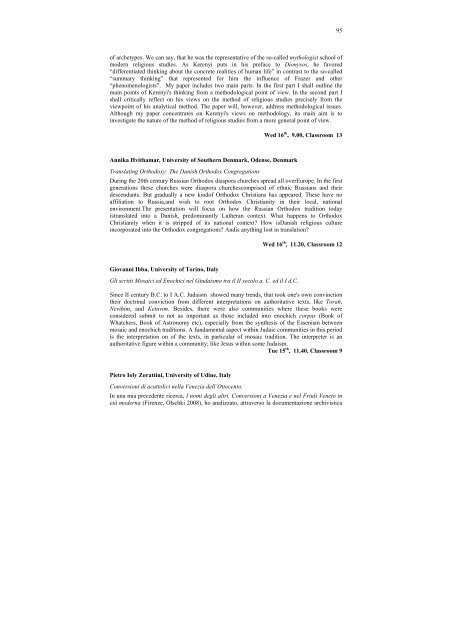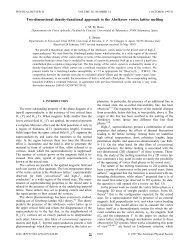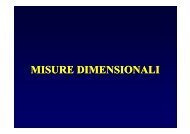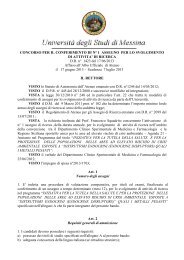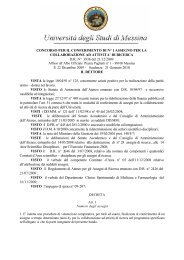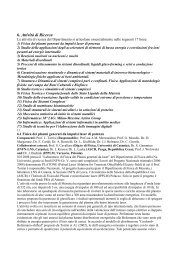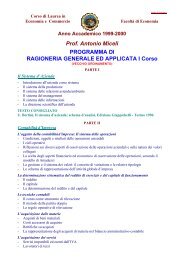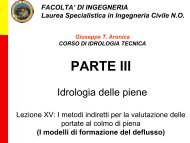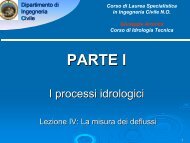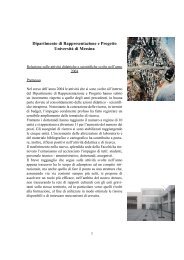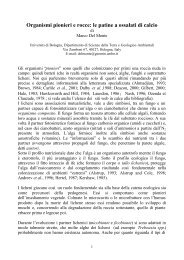PROGRAMME AND ABSTRACTS - Università degli Studi di Messina
PROGRAMME AND ABSTRACTS - Università degli Studi di Messina
PROGRAMME AND ABSTRACTS - Università degli Studi di Messina
You also want an ePaper? Increase the reach of your titles
YUMPU automatically turns print PDFs into web optimized ePapers that Google loves.
of archetypes. We can say, that he was the representative of the so-called mythologist school of<br />
modern religious stu<strong>di</strong>es. As Kerenyi puts in his preface to Dionysos, he favored<br />
“<strong>di</strong>fferentiated thinking about the concrete realities of human life” in contrast to the so-called<br />
“summary thinking” that represented for him the influence of Frazer and other<br />
“phenomenologists”. My paper includes two main parts. In the first part I shall outline the<br />
main points of Kerenyi's thinking from a methodological point of view. In the second part I<br />
shall critically reflect on his views on the method of religious stu<strong>di</strong>es precisely from the<br />
viewpoint of his analytical method. The paper will, however, address methodological issues.<br />
Although my paper concentrates on Kerenyi's views on methodology, its main aim is to<br />
investigate the nature of the method of religious stu<strong>di</strong>es from a more general point of view.<br />
Annika Hvithamar, University of Southern Denmark, Odense, Denmark<br />
Translating Orthodoxy: The Danish Orthodox Congregations<br />
95<br />
Wed 16 th , 9.00, Classroom 13<br />
During the 20th century Russian Orthodox <strong>di</strong>aspora churches spread all overEurope. In the first<br />
generations these churches were <strong>di</strong>aspora churchescomprised of ethnic Russians and their<br />
descendants. But gradually a new kindof Orthodox Christians has appeared. These have no<br />
affiliation to Russia,and wish to root Orthodox Christianity in their local, national<br />
environment.The presentation will focus on how the Russian Orthodox tra<strong>di</strong>tion today<br />
istranslated into a Danish, predominantly Lutheran context. What happens to Orthodox<br />
Christianity when it is stripped of its national context? How isDanish religious culture<br />
incorporated into the Orthodox congregations? An<strong>di</strong>s anything lost in translation?<br />
Giovanni Ibba, University of Torino, Italy<br />
Gli scritti Mosaici ed Enochici nel Giudaismo tra il II secolo a. C. ed il I d.C.<br />
Wed 16 th , 11.20, Classroom 12<br />
Since II century B.C. to I A.C. Judaism showed many trends, that took one's own convinction<br />
their doctrinal conviction from <strong>di</strong>fferent interpretations on authoritative texts, like Torah,<br />
Nevihim, and Ketuvim. Besides, there were also communities where these books were<br />
considered submit to not as important as those included into enochich corpus (Book of<br />
Whatchers, Book of Astronomy etc), especially from the synthesis of the Essenism between<br />
mosaic and enochich tra<strong>di</strong>tions. A fundamental aspect within Judaic communities in this period<br />
is the interpretation on of the texts, in particular of mosaic tra<strong>di</strong>tion. The interpreter is an<br />
authoritative figure within a community; like Jesus within some Judaism.<br />
Tue 15 th , 11.40, Classroom 9<br />
Pietro Ioly Zorattini, University of U<strong>di</strong>ne, Italy<br />
Conversioni <strong>di</strong> acattolici nella Venezia dell’Ottocento.<br />
In una mia precedente ricerca, I nomi <strong>degli</strong> altri. Conversioni a Venezia e nel Friuli Veneto in<br />
età moderna (Firenze, Olschki 2008), ho analizzato, attraverso la documentazione archivistica


